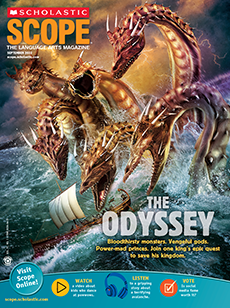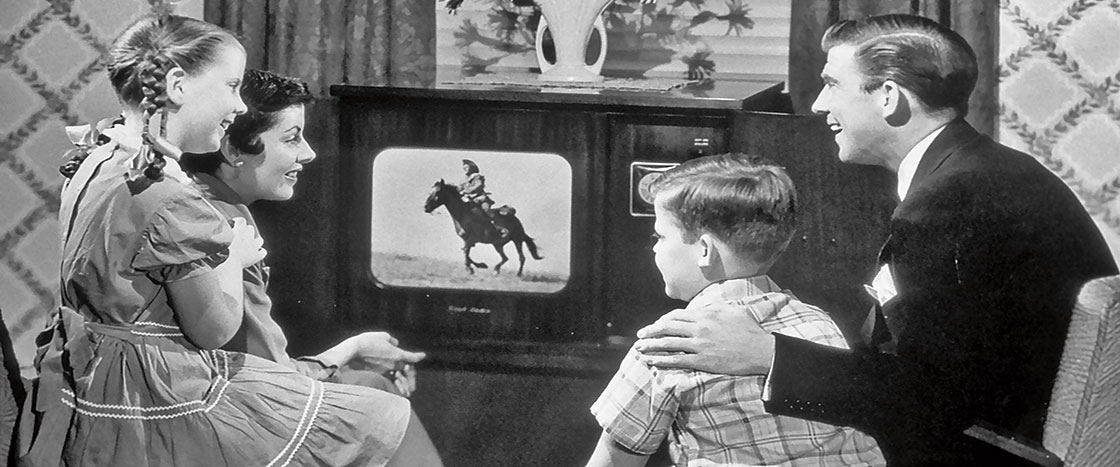“The Box That Changed America” (20 minutes)
Read the article as a class. Then discuss the following.
Close-Reading Questions
How does author Lauren Tarshis convey the excitement surrounding TV in the mid-1940s? (author’s craft) Tarshis conveys the excitement surrounding television in the mid-1940s by describing the delivery of the Rosses’ television: She writes that the family “hurried outside” and “watched with excitement” as the deliverymen brought in the TV. Then Tarshis writes, “Families like the Rosses would rush through dinner so they could sit together for their favorite shows.” These details demonstrate how exciting TV was at the time.
Based on the article, does it seem likely that many people owned TVs in the 1940s? Provide at least one piece of text evidence to support your answer. (inference) No, it does not seem likely because televisions were very expensive. Tarshis makes this clear when she writes that a TV in the 1940s could cost “nearly three months’ salary for the average American.”
On page 21, Tarshis writes, “At the same time, TV was becoming a powerful cultural force that brought Americans together.” How does she support this idea? (key ideas and supporting details) Tarshis supports the idea that TV bonded Americans by explaining that people in all parts of the country watched the same shows. Tarshis then lists several examples of historic moments that Americans were able to experience together because of television.
Read the sidebar “Small Screens, Big Changes.” Compare the shows mentioned in the sidebar with the shows mentioned in the section “Bigger Screens.” What can you conclude about how TV changed between the 1950s and the 1970s? (text features, synthesis) The TV shows mentioned in the section “Bigger Screens” are about dogs, puppets, and cowboys. The shows mentioned in the sidebar are about diverse families and serious issues like slavery. You can conclude that TV shows became more realistic and serious between the 1950s and the 1970s.
“Television Transformed” (20 minutes)
Read the article as a class. Then discuss the following questions, some of which refer to both texts.
Close-Reading Questions
What point or points about modern television is Tarshis making in the introduction? (key ideas, inference) In the introduction, Tarshis is making the points that watching TV is still a popular pastime and that it is no longer a shared experience, but rather, something people often do on their own.
How did the invention of cable TV affect television watching in America? (key ideas) Cable TV divided television audiences. The creation of many new channels and shows made it possible for people to choose shows that particularly interested them, whereas before cable TV, there were only a few shows available, so everyone watched the same things.
Compare the main image on page 20 with the main image on page 22. Together, what story do these photos tell about how TV has changed? (text features) Together, the photos tell the story of how watching TV has changed from a shared activity (illustrated by the happy family gathered around a TV) to an activity people often do on their own (illustrated by four people each looking at a separate screen).
Critical-Thinking Questions
Over the past 40 years, there have been many changes in TV programming and technology. How have these changes improved our TV-watching experience? Cable TV, with its wide range of channels and shows, has given us the opportunity to watch shows we really care about. The internet, computers, and smartphones have made watching TV more convenient: Now we can watch wherever and whenever we want.
In “Television Transformed,” Tarshis explains that today, Americans can choose from many different news sources, “each with a different point of view.” Is this a positive or a negative change from how Americans got news in the 1950s? Or, is it a little bit of both? Answers will vary. Students may say that the way we get news today is better than in the past, when all Americans got their news from the same nightly broadcasts, because the more sources of information available and the more points of view we can hear, the more informed we can be and the broader our perspective will be. On the other hand, today people have the option to take in only news that reinforces their own points of view or beliefs, which could lead to closed-mindedness. And, with so many options, it can be hard to know which sources to trust.
In what ways, if any, might you change your TV-watching habits after reading these articles? Answers will vary. Students might suggest that they will watch TV with their families more often or watch new shows to learn about other people’s interests or points of view.

